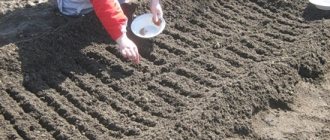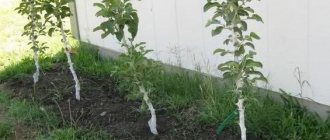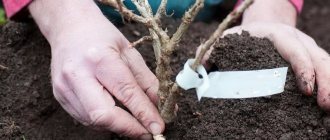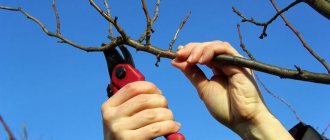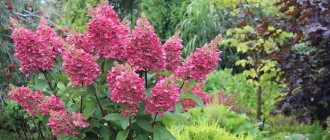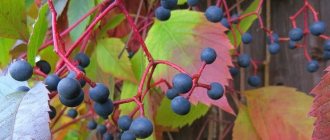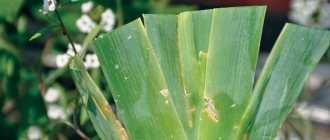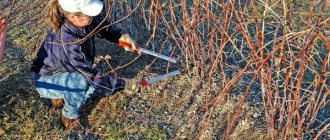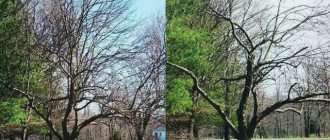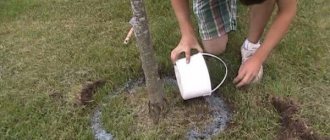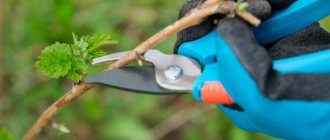To preserve the decorative appearance and productivity of gooseberries, prune old and diseased branches and young shoots correctly and in a timely manner. Otherwise, the crown of this perennial plant thickens, the bush begins to hurt, bears sour berries, and may even die. It's time to learn the rules and secrets of pruning gooseberries in the autumn.
When to prune gooseberries?
Pruning gooseberries is an important procedure if the gardener is concerned about the high yield of the plant. You can form a bush in summer, spring and autumn, but each season has its own nuances:
- In the spring . Pruning is carried out in early March - even before the first buds appear (in the first ten days). If you break this rule, the bush will not bear fruit at all this year. Prune gooseberries when the last snow has melted, the night frosts have ended, and the weather improves.
- In autumn. If the spring time for pruning gooseberries is missed, the bush can be formed in the fall. The main thing is to finish pruning the gooseberries before the onset of the first cold weather (late October-early November). This time of year has its advantages. For example, you can cut off all broken, diseased, dry and simply unnecessary branches right down to the very base. In the spring, all that remains is to slightly adjust the bush, which will not affect its fruiting in any way.
- In summer. During this period, pruning gooseberries is necessary to preserve and increase productivity. Remove young shoots to a height of seven leaves, and carefully cut out zero stems. The plant spends a lot of energy on them, and the berries do not have time to ripen and remain sour.
It doesn’t matter when the gooseberries are pruned - in autumn, summer or spring, large cuts must be treated with garden varnish. Otherwise, the plant’s immunity decreases, and it may get sick and die. In summer, minor adjustments to the bush are made, without radical manipulation.
Autumn pruning
After the summer season, it is much easier for an attentive gardener to determine which branches will need to be pruned, which ones bore berries, what kind of shoot growth there was and in which direction they stretch. The whole picture becomes completely clear. This is why autumn pruning is so valued. However, it is better to assign it the role of a cleansing and preparatory procedure - radical changes should not be made. The bush should go into a dormant state without serious losses.
Autumn pruning is done to cleanse and rejuvenate the crown of the bush, which will increase the number of berries and their quality in the future.
Before pruning, the bush is inspected for the presence of dry and blackened shoots. Usually these are old branches that have lived for seven or more years. They need to be cut off at the root. The same fate will befall the shoots that did not bear fruit in the past season.
The side branches are cut by a quarter, the cut point is located a centimeter above the bud looking outward. Shoots with thin ends are cut to the first large bud. Those growing crosswise or in the wrong direction are pruned to the point where they will no longer interfere with others. Branches with poor annual growth (up to 7 cm) are shortened to strong growth.
The result will be many cuts, including large ones - they should be covered with garden varnish. After the pruning procedure, 4-5 strong shoots may remain on the bush - this is a completely normal number, and it usually makes up a third of all large and medium-sized shoots. Next year, due to its growth rate, the bush will already have ten or more branches. His health will only get stronger from this, not to mention the volume of the harvest.
Autumn pruning of gooseberries is often called rejuvenating
Video: how to prune correctly in the fall
Why is the gooseberry pruning procedure necessary?
Over several years, gooseberries produce from 50 to 70 new shoots, which only thicken the crown of the bush. As a result, the plant does not receive enough light, heat and oxygen, and the risk of fungal infection increases. In order not to ruin the gooseberries, it is important to prune them on time.
Other reasons for planned pruning of gooseberries in the autumn:
- harm from insects, which are more often found in dense crowns;
- increasing productivity;
- decorative type of shrub;
- simplifying gooseberry care;
- sanitization;
- preparation for landing;
- better heating of the root system.
Carry out autumn pruning of the bush only after the leaves have fallen. In September, young shoots may still appear, which, before they have time to become woody, die. In the second half of October, remove old and diseased stems, and leave the formation of the crown until early spring.
Obviously, it is easier to care for a thinned plant than to wade through thorns and thickets in search of useful berries.
When to prune gooseberries
Each gardener has his own point of view on the time of pruning gooseberries. Some people like spring work, when sap flow has not yet begun in the plants. Others prefer to trim in the autumn days after the end of the fruiting period, thereby preparing the bushes and trees for the dormant period.
In the spring, you should hurry up with pruning before the vegetation processes intensify. But gooseberry buds wake up early, and if you miss the moment of sap flow, you can cause more harm to the plant than good. A weakened shrub will have difficulty blooming and producing a good harvest.
Therefore, without having time to prune in the spring, it is better to postpone it until the cold weather, especially since many gardeners choose this particular period to take care of the bush. When pruning gooseberries in the fall, it is important for novice gardeners not to waste time. The recommended period is October - November after the leaves fall. But you should pay attention to the weather, you don’t need to wait for frosts and sub-zero temperatures. Sometimes pruning is done in two stages. In the summer, after harvesting, all dried and diseased branches are removed from the bush, and in the fall, a formative and rejuvenating haircut is carried out.
Types of gooseberry pruning
There are 2 types of bush formation - pre-planting and rejuvenating. In the first case, we are talking about planting seedlings, in the second, about rejuvenating an already perennial plant in order to increase productivity. Both procedures have characteristic features and are equally beneficial for gooseberries.
Pre-landing
In order for gooseberries to develop well and bear fruit after planting, they need to be pruned. Remove weak, deformed and lifeless shoots, shorten the rest to the size of 4 buds (for weak plants - up to 2 buds). Before planting, radically prune the plant, which will increase its fertility and vitality.
The main purpose of pre-planting pruning of gooseberries is to strengthen the root system, set the rate of growth and fruiting of the young plant.
Rejuvenating
This procedure is necessary for adult plants if the gardener notices a dynamic decrease in yield. The optimal age for rejuvenating gooseberry pruning is 8 years and older. Form a bush annually after harvest. There are several options:
- In late autumn, remove a third of all shoots, completely get rid of the horizontal root shoots, which take all the water and nutrients from the soil. Shorten young shoots from the soil to 20 cm, no more.
- In order not to cut out the entire gooseberry, cut off its crown so that the maximum length of each stem does not exceed 15-20 cm. Be sure to remove root shoots and diseased stems.
Experienced gardeners claim that after rejuvenation, plants that previously remained without fruit for several years begin to bear fruit. In addition, this is an excellent prevention of many diseases and pests of gooseberries.
How to prune correctly for beginners
Gooseberry pruning scheme
For beginners, pruning shrubs is always somewhat difficult, as it requires knowledge and experience. To prevent gooseberry bushes from turning into thickets, they require regular pruning, taking into account the age and condition of the plant.
Since it is undesirable to make cuts on living things, and it is not always possible to get to the site in early spring, experts recommend autumn pruning. To work you will need pruners and loppers.
Old bush
A bush that is 5 or more years old is considered middle-aged. At this age, there are more than 30 shoots of different ages on the plant; it is difficult for the roots to provide nutrition to such an abundant vegetative mass and this negatively affects the volume of the harvest. That is why the bush needs rejuvenation. During pruning, only strong basal branches are left, and all young shoots are cut off.
On bushes that are too old, no more than 5 powerful branches should be left, and all the rest should be removed. In the spring, the gooseberry will produce many young shoots and grow its crown again. Radical pruning stimulates the growth of zero shoots from the base of the bush, and the plant gradually completely rejuvenates.
Subsequently, all shoots that have stopped bearing fruit are removed from the bush. As a rule, these are branches older than 7 years, distinguished by dark-colored bark. By the age of eight, the bush should have up to 8 main branches and up to 24 shoots of different ages. Specimens that have reached 20 years of age are not rejuvenated, but replaced with new plants.
On a note! Using the branches remaining after pruning, you can propagate the crop by cuttings.
Features of pruning a young bush
Peak fruiting of gooseberries occurs from the age of five to ten years. It is important to form the correct crown in advance at this time. This should happen like this:
- At the age of one year, all weak and broken branches are cut out from the seedling, and the tops at the level of 2-3 buds are removed from strong shoots.
- When the bush is 2 years old, 3-4 of the strongest branches are left on it, shortening them by 1/3, everything else is cut off close to the ground. The crown will be formed from the remaining trunks in the future.
- On 3-year-old and 4-year-old bushes, no more than 4 main trunks are also left. Zero shoots that grow close to the ground are completely removed, and all remaining branches are cut by a third.
- For a 5-year-old bush, formative pruning is no longer relevant. At this age, the crown takes on a finished appearance. The plant only needs sanitary pruning and control over the number of shoots so that the crown does not thicken.
Important! Autumn pruning is often carried out in two stages. The first stage takes place immediately after harvesting, during which diseased and withered branches are cut out. Shortening pruning should be carried out only at the second stage, in late autumn, after the end of sap flow.
As gardeners gain experience, they begin to grow gooseberries on a trunk or trellis method; in these cases, completely different formative pruning is used. To form a trunk, a single strong shoot is left, which will serve as a trunk. And when growing on trellises, the emphasis is on horizontal growth of shoots, leaving several strong branches.
What will you need for work?
Even a professional cannot cope with pruning gooseberries without garden tools. Important: do not damage the plant, do not injure yourself.
For the planned procedure you will need:
- thick rubber gloves;
- pruner;
- garden saw;
- lopper;
- gardening scissors;
- paint/chalk;
- garden var;
- robe with long sleeves.
Choose pruners with single- and double-sided sharpening. It is important to sharpen the blade well, otherwise the stems will not be cut, but will break.
After use, garden tools must be sterilized. Important criteria for choosing such equipment are the quality of materials, the presence of rubberized handles, ease of use, and long service life. Otherwise, you will have to buy gardening tools every season.
To learn how to trim gooseberries using hedge trimmers, watch the following video:
Selecting Tools
In order for the upcoming gooseberry pruning to be successful, it is important to use suitable garden tools. The first thing you need to do is find a sharp pruner and a lopper. It is also important to take care of personal safety and wear protective cotton gloves. They will protect your hands from possible contact with spikes or sharp tools.
The pruner is designed to quickly remove small branches that are on the surface. It is impossible to process thick branches with such a tool. For old bushes with thick branches, it is better to use a sharp hacksaw or professional lopper. The latter device effectively cuts powerful branches up to 5 centimeters thick, which are located deep in the bush.
When choosing garden tools, you need to be guided by some criteria and check whether it meets certain requirements:
- Reliability and durability. The tools used must not be damaged by significant impact, for example when removing thick branches and twigs.
- Sharpness. The quality of blade sharpening must be high. It should not contain nicks or other defects.
- Minimum weight. For comfortable pruning, use lightweight tools. Carrying out gardening work with heavy equipment is much more difficult than with light ones.
- Ease of use. Any cutting tool should have a comfortable handle. In addition to a comfortable shape, it should be equipped with rubber inserts that prevent your hands from slipping.
Advice!
Garden shears with long handles will also be a useful tool. To treat the cutting areas, it is customary to use garden varnish.
A wheelbarrow is used to remove wood waste. In addition, the gardener needs to purchase various disinfectants that can be used to treat parts of the plant affected by bacteria and fungi.
Which shoots need to be cut out?
The first rule: you cannot cut off everything that seems ugly and unnecessary. This is especially true for novice gardeners. Such radical methods cause severe stress in the plant, and it stops bearing fruit. After cutting, a third of the crown should remain, otherwise the gooseberry will die.
To give the bush an aesthetic appearance, the following must be removed:
- black, dry branches:
- damaged, diseased shoots;
- competing sprouts;
- branches located inside the bush;
- horizontal growth;
- basal shoots.
Visually inspect the bush and remove all its “weak points”, but do not get too carried away with pruning the branches. Having cut off more than half of the crown, the plant dies. The exception is when gooseberries are rejuvenated in this way.
Bush formation
As for the work on shaping the crown shape, its intensity is determined by the age and other characteristics of the bush. To determine your current age, just look at the bark, guided by the following principles:
- Young specimens have smooth bark with an intense greenish tint.
- Old shoots are covered with rough, thick bark with dark gray shades.
The first pruning is carried out before the spring rooting of young seedlings. It involves removing the tops of all branches, and in such a way that no more than four buds remain from the root system. This approach will be a good stimulation for the formation of fruiting branches upon the return of the warm season. When doing such pruning, it is necessary to eliminate dead branches, removing them to the point where fresh shoots form.
Beginning gardeners should understand that during the first two to three years the shrub will not bear fruit in as much quantity as expected. However, this does not mean that culture should not be taken care of and all the nuances of proper care should be ignored. The period of best fruiting occurs in the 5th to 10th years of life, after which it worsens. To launch natural growth stimulation and increase productivity, it is enough to carry out effective bush formation. To do this you need to perform the following activities:
- In the first year of life, weak and damaged shoots are removed from the plant. Strong and robust seedlings are pruned to 2-3 buds at the top.
- Two-year-old bushes are formed in such a way that 3 or 4 powerful trunks remain.
- Three- and four-year-old plants should have main shoots, preferably no more than 4-5 copies. Zero shoots are removed at the very base, and a third of the length is removed from the rest of the shoots.
- Five-year-old shrubs do not need shaping pruning. It is enough to promptly clear them of weak, diseased and dead shoots, which take away useful microelements and worsen yield indicators.
The remaining pruning work is aimed at clearing the crop of non-fruit-bearing shoots. In most cases, this concerns 7-8 year old specimens, which are slightly twisted and have dark bark.
Step-by-step instructions for pruning gooseberries
Make it a rule to prune adult gooseberries in spring and autumn, and clearly choose a favorable period for such an activity. Below is a classic scheme of the anti-aging procedure:
- Select a central branch and cut it to its minimum length.
- Remove side shoots extending from it.
- Cut out branches that have been observed not to bear fruit.
- Be sure to remove horizontal root growth.
- Do not touch old branches with young shoots yet.
Pruning root shoots is a separate issue. The gooseberry variety plays a decisive role. Some form a crown after 3 years, others after 5 years. Therefore, first remove diseased and lifeless shoots, and then those that interfere with growth and create shadow.
To learn how to prune gooseberries quickly, correctly, and so that there is a good harvest, watch the following video:
Methods for forming a bush
To properly remove branches and preserve the harvest, decide on the method of forming the bush. There are several options, including:
- standard;
- trellis;
- classical.
Each method has its own advantages, but long-term practice of gardeners shows that the richest harvests are after the classical formation of the bush. Gooseberries are tasty, sweet and large.
Other methods also have their advantages, for example, the standard method saves space in the garden, and installing trellises simplifies the harvesting process. The choice, in any case, remains with the gardener, who will have to care for the gooseberries in the fall.
Standard gooseberry
In this case, the trimmed gooseberry bush resembles a small tree, which is compact in size and takes up little space in the garden. The height of the renewed plant does not exceed 1 m. Stages of formation of such a shrub:
- Select the strongest, most massive shoot from the central part of the bush.
- Remove the remaining branches at the root.
- Dig a metal pipe or stick into the ground nearby (this is a support).
- Attach the central shoot to the support, do not press down the plant.
- Next spring, remove the top to allow the bush to expand.
- Cut last year's shoots in half, leaving 4-5 of the young shoots.
- In autumn, remove old, dried and diseased branches.
- As they appear, uproot the root shoots, which take away all the strength of the plant.
With this pruning, the bush-tree produces good fruit, all branches receive a sufficient amount of light and oxygen. The disadvantages of this method include the short lifespan of gooseberries, poor frost resistance, and weak immunity. On average, such a dwarf tree will live 12 years, no more.
Gooseberries on a trellis
In this case, a trellis is used to trim the bush. This is a special device that consists of vertical posts and a wire stretched between them in 3 tiers - at a height of 50, 80 and 100 cm from the ground. Sequence of actions for a novice gardener:
- Plant seedlings in 1 row at a distance of 100 cm from each other.
- Dig metal pipes between the bushes.
- Connect the stakes with wire in 3 tiers at the distance indicated above.
- As the shoots grow, tie them to the trellis tiers with a thin thread.
- Remove excess branches, get rid of root shoots.
- Every year, shorten last year's shoots by a third.
- Tie up fresh stems in 4-5 pieces.
This makes it easier for young branches to grow and provides unimpeded access to oxygen and light. In addition, it is much easier to harvest from trellises; you won’t get hurt on a thorn and you won’t have to break elastic shoots.
The classic way to form gooseberries
In this case, the natural shape of the crown does not change, and pruning of the gooseberries is carried out for preventive and decorative purposes. The sequence of actions is as follows:
- Year of planting. Remove diseased and lifeless branches, shorten seedlings to 3-4 buds in height.
- 1 year. Leave 3 healthy shoots, from which the crown of the bush will form in the future. Pre-cut off a third of the top.
- 2nd year Remove last year's branches and root shoots. Cut young stems (up to 4 pieces) that appear closer to autumn in half, otherwise they will freeze and die.
- 3rd year. The crown of the bush has already been formed (up to 12 branches), so simply remove weak, deformed, dry and old branches, be sure to get rid of the horizontal root shoots, leave 3 young shoots.
- 4 year Trim last year's branches by 5 cm, continue to remove root shoots, and remove side shoots by a third.
- 5 and subsequent years. Make sure that the gooseberry crown does not thicken; remove side shoots in a timely manner.
An adult plant aged 7-8 years has up to 22-24 branches of different ages that bear fruit well. Gradually remove old, dried and damaged shoots, thereby rejuvenating the gooseberry bush.
Formation of a trunk
Gooseberries can be grown as a small tree, forming a trunk from an early age. Such a tree-bush looks very impressive in the garden, and harvesting from it is much easier. To get a beautiful bush, you need to start pruning the gooseberries in the spring.
To create standard gooseberries, select varieties with upright, strong shoots. This is an important condition, since dense branches (more precisely, one of the strongest branches) are required to obtain a trunk.
Pruning of the bush begins the next season after planting. The highest quality upright shoot is selected, and the rest is cut off at the very roots. The top of the main shoot is shortened by 1-2 buds. They also carry out a blinding procedure: all the buds in the lower part of the future trunk are removed, leaving only about 4-5 buds at the top. It is better to tie the main shoot to a support, which is installed simultaneously with planting the plant.
To get a tall, beautiful trunk, you need to constantly care for the plant: feed it regularly, water it on time, loosen the soil.
In the second and third years, the tree is shortened by ½ the length of all lateral branches that grew from the remaining buds. You need to focus on the buds directed into the bush. In this way, the new growth will not wilt, but will grow horizontally or upward, creating a lush crown.
In the future, shortening of the branches is not performed. Only sanitary pruning of old, weakened, unhealthy and competing shoots is carried out. It is important to regularly cut out all the shoots that grow at the roots of the trunk. Otherwise, the bush will lose strength and will not be able to develop into a tree.
Caring for gooseberries after pruning
Even proper pruning of gooseberries becomes stressful for the plant. To form an aesthetic crown and maintain the fertility of the bush, follow these valuable recommendations from experienced gardeners:
- Treat large sections with garden pitch, urea solution or crushed activated carbon.
- Immediately after pruning, fertilize the plant. Use special fertilizers or a mixture of 15 kg of humus, 40 g of potassium, 200 g of superphosphate.
- Water the gooseberries. For each bush - about 2 full buckets of water at room temperature.
- Since the bushes are weakened after pruning, spray them with Bordeaux mixture. This is a good prevention against harmful insects.
- Use sheet compost, mulch or a layer of peat to insulate the root system and prepare the plant for the upcoming cold weather and wintering.
If there is a pest threat, use fungicides. Among the most effective are the drugs Flint Star, Coronet, Antrakop, Infinito, Teldor. For prevention, spray not only the plant, but also the soil underneath it. Instructions are included on the packaging.
Common mistakes gardeners make when pruning gooseberries
Beginning gardeners often make mistakes when pruning gooseberries and count on a rich harvest. There will either be no fruits at all, or their taste leaves much to be desired. The most common mistakes made by new gardeners:
- Violation of pruning deadlines. In spring, the period of bud emergence is considered forbidden; in autumn, the first frosts and cold weather are considered forbidden.
- Unconscious removal of branches. It may seem that this will be more beautiful, but in reality the plant suffers and dies.
- Removing the entire crown when rejuvenating the bush. A global error can lead to the death of the bush.
- Cutting off annual shoots on which young shoots have already appeared. Gooseberry fruiting is reduced for every season.
If the leaves of the plant have fallen off, this is a sign of disease. Among the provoking factors is powdery mildew. You can examine the inside of the leaf and detect harmful moths. Treatment of a diseased plant should follow immediately.
Proper pruning of shoots in autumn and preparation for winter
If the main pruning was not done in the spring, then in the fall it’s time to do it and renew the bush. It should be carried out at the end of October and not earlier, so that during the autumn thaws the side shoots do not begin to grow. They will no longer have time to become lignified and will certainly freeze out in the winter.
Old, broken, diseased, weak young branches and branches growing deep into the bush are removed. Zero shoots are shortened by a quarter of its length.
If the end of the branch is thin, this indicates that the branch is weak, there will be no harvest on it, and so that the apical bud does not draw food onto itself, it must also be shortened to the largest bud looking outward. The result of pruning should be a well-lighted bush.
Useful tips
To avoid mistakes and prune shrubs correctly, follow these valuable recommendations:
- If the plant is very overgrown, do not delay pruning the bush, otherwise the gooseberry will not bear fruit. With intertwined branches, the fruits are small and sour.
- Cut branches at an angle. When cut directly, young shoots grow inside the crown, which reduces gooseberry yield.
- For the first 2 years, do not carry out radical pruning of the bush, just shorten newly emerging shoots by half.
- Make sure that a neglected shrub does not take root by layering without permission. Otherwise, the yield is reduced and the mother plant is depleted.
- In one season, cut off no more than a third of the branches; more radical cutting harms the perennial plant.
- If the harvest is poor, cut the stem to the side branches with young shoots.
- Be sure to collect and burn dry branches to minimize the risk of fungal infection.
Gooseberries are unpretentious in care, but leaving the plant without attention is also not recommended. Monitor the crown, remove diseased and dry shoots, and follow preventive measures. Remember that the yield and health of a perennial plant depend on the rules of care.
0
0
Copy link
Anti-aging pruning of gooseberry plantings
Skeletal branches extending from the rhizome reach peak fruiting between three and six years of age. Then the number of fruits gradually decreases and the ten-year-old shoot practically no longer bears fruit. Therefore, 6–7 after planting, the gooseberries need to be rejuvenated, as the bush gradually begins to age. To prolong its full life, it is necessary to get rid of aged branches and replace them with new ones. It is impossible to immediately cut out all the old shoots, because a plant without branches will die.
Old unkempt bushes turn into impassable thickets
The rejuvenation procedure is carried out in several stages:
- The bush is mentally divided into three approximately equal parts. In the first year, in late autumn, all branches are removed from 1/3 of the bush. This stimulates increased growth of zero shoots. To make it easier for the plant to survive the execution, gooseberry plantings are generously fertilized with humus. To do this, apply at least 2-3 buckets of organic fertilizer under each bush.
- The next season (a year later), the new zero shoots that appear are shortened by a quarter of the length. Then cut out the next third of the remaining old branches.
- After another year, remove the remaining unnecessary old part and trim the fresh branches by ¼.
Rejuvenating pruning removes old branches
If you carry out timely annual pruning of the bush, then rejuvenation will not be necessary. All branches that are older than 10 years must be removed on time. This radical rejuvenating procedure is required only when the bush is neglected. After 30 years, plants are no longer rejuvenated; such bushes are simply uprooted.
Gooseberries can be trimmed in different ways
There is another way of anti-aging pruning, which involves removing absolutely all shoots. At the same time, stumps are left, about 10–15 cm high, from which fresh shoots will come. Sometimes with this method it is recommended to leave 3-5 of the strongest and most developed branches. After the formation of the bush is completed, they are removed.
After radical pruning, the gooseberries need to be fed well
In old bushes, the rhizome grows so much that only stumps remain in the middle, and young shoots grow only around the central part. Our gooseberry bushes stopped bearing fruit properly after about 15 years. They tried to do rejuvenation, but it was too late. The bush produced few fresh shoots and there were very few berries. The outer branches constantly fell towards the ground and the plantings began to take up too much space. I had to cut everything out completely. But there were a few branches left with roots that managed to take root; they were planted separately in another place.
